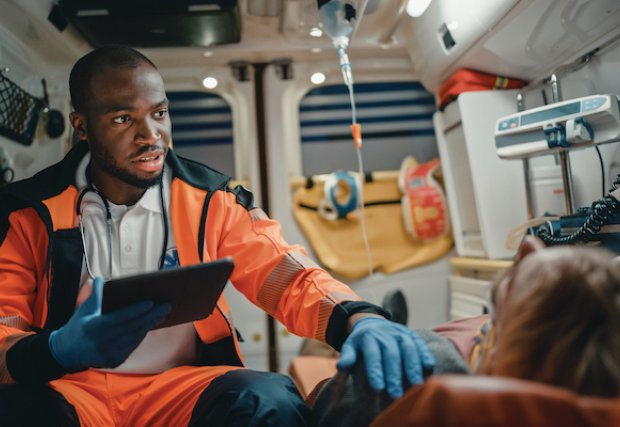GW Hospital Celebrates One Year of Providing Whole Blood to DC EMS

The George Washington University Hospital (GW Hospital) and DC Fire and EMS Department are celebrating one year of saving lives through the Low Titer O Whole Blood Program (LTOWB). The program, the first of its kind in DC, provides EMS units with low titer O whole blood from GW Hospital’s blood bank so lifesaving transfusions can take place in the field before the patient gets to a hospital.
“GW Hospital is proud to continue leading innovation by supporting DC’s pre-hospital whole blood initiative,” said Xiomara Fernandez, MD, Director of Transfusion Medicine and Assistant Professor of Pathology and Laboratory Medicine at GW Hospital. “Our blood bank’s expertise and commitment have made this regional advancement possible. GW Hospital’s blood bank provides all the testing, quality assurance and clinical oversight to ensure that every unit of whole blood used in the field is safe, effective and ready to save lives.”
From the program’s start in April 2024 through April 2025, 248 patients received more than 266 units of blood with an overall survival rate of 86 percent and an impressive 96 percent survival rate for those not found in cardiac arrest, according to DC Fire and EMS Department data.
Blood for the program is collected from volunteer donors by the American Red Cross, screened for diseases and verified to have non-significant levels (low titers) of antibodies against Type A or B blood. White blood cells are filtered out, but the blood is left whole with plasma and platelets to promote clotting and red blood cells to carry oxygen. The American Red Cross then sends the blood for the program to GW Hospital where the blood bank tests and stores the blood until it is ready for pick up by DC Fire and EMS.
"DC Fire and EMS is a vital part of the District's healthcare system,” said David A. Vitberg, MD, Medical Director for DC Fire and EMS. “What our EMS clinicians do, or don't do, in the pre-hospital setting can have a profound impact on patient outcomes. Our partnership with GW Hospital to launch and sustain our Low-Titer Type-O Whole Blood Transfusion Program has dramatically improved the landscape of pre-hospital care in the District. Accelerated, evidence-based, high-quality care for time-sensitive injuries and illnesses saves lives. This partnership is a shining example of how EMS and hospitals must work together to create a seamless experience for our patients - and achieve the best possible outcomes."
When a patient suffers a traumatic injury or experiences major bleeding, doctors typically give blood to a patient when they arrive at the hospital. Without rapid blood transfusion, patients with life-threatening bleeding can die.
Babak Sarani, MD, Chief of Trauma Surgery at GW Hospital, said before pre-hospital infusions were available, patients who were losing a lot of blood often wouldn’t survive after arriving at a hospital. “The Whole Blood Program has bought them 20-30 minutes of life, which is key for that transport in the ambulance.” Dr. Sarani said. “The most common cause of possibly preventable death following injury remains blood loss and the sooner transfusion can be started, the higher the chances that the patient will survive.”
Of the 248 patients treated from April 2024 to April 2025, 144 cases were the result of a shooting, 47 resulted from a medical event and 43 were from a stabbing. Residents from Wards 7 and 8 accounted for 145 of the 248 cases while 79 percent of the patients were male with an average age of 33 years old.
